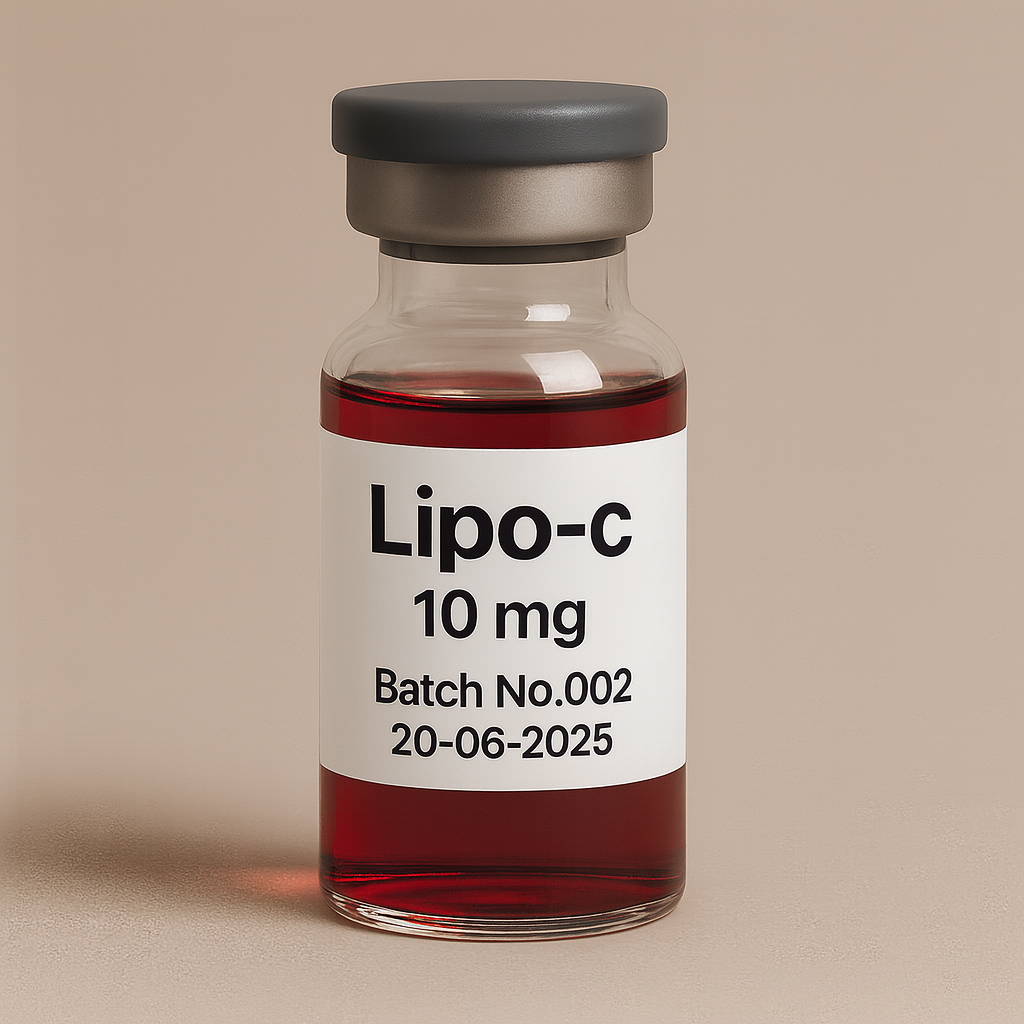
Lipo-c 10mg vial
Pickup currently not available
NOT FOR HUMAN CONSUMPTION
Lipo-C, commonly referred to as MIC injections (denoting Methionine, Inositol, and Choline), are a blend of lipotropic compounds and essential nutrients designed to enhance fat metabolism and support weight management. These injections are often utilized as adjuncts in weight loss programs, aiming to facilitate the breakdown and elimination of fat, boost energy levels, and improve overall metabolic function.
2. Composition and Mechanism of Action
2.1. Key Components
-
Methionine: An essential amino acid that aids in the breakdown of fats and helps prevent the accumulation of fat in the liver. It also assists in detoxifying harmful substances in the body.
-
Inositol: Aids in the metabolism of fats and helps reduce blood cholesterol. It also participates in the action of serotonin, a neurotransmitter known to control mood and appetite.
-
Choline: Supports the health of the liver in its processing and excretion of chemical waste products. It is required for the transport and metabolism of fats and cholesterol within the body.
-
Vitamin B12 (Cobalamin): Plays a vital role in maintaining the health of nerve cells and red blood cells. It is also needed to make DNA, the genetic material in all cells.
-
L-Carnitine: Facilitates the transport of fatty acids into the mitochondria of cells, where they are oxidized to produce energy.
-
Vitamin B1 (Thiamine) and B5 (Pantothenic Acid): Essential for energy metabolism and the synthesis of neurotransmitters.
2.2. Mechanism of Action
The synergistic effect of these components is believed to:
-
Enhance the liver's ability to process and eliminate fats.
-
Increase the body's metabolic rate, leading to more calories burned.
-
Boost energy levels, facilitating increased physical activity.
-
Support the maintenance of lean muscle mass during weight loss.
3. Clinical Efficacy
While anecdotal reports and some clinical practices suggest benefits of Lipo-C injections in weight management, it's important to note that:
-
Scientific Evidence: There is limited peer-reviewed research specifically evaluating the efficacy of Lipo-C injections for weight loss. Most evidence is anecdotal or based on small-scale studies.
-
Adjunctive Role: Lipo-C injections are typically used in conjunction with calorie-restricted diets and exercise programs, making it challenging to isolate their individual effects.
-
Individual Variability: Responses to Lipo-C injections can vary widely among individuals, influenced by factors such as baseline metabolic rate, diet, exercise habits, and genetic predispositions.
4. Safety and Tolerability
4.1. Common Side Effects
-
Mild discomfort or pain at the injection site.
-
Nausea or gastrointestinal upset.
-
Headache or lightheadedness.
4.2. Rare but Serious Side Effects
-
Allergic reactions, including rash, itching, or swelling.
-
Dizziness or difficulty breathing.
4.3. Contraindications and Precautions
-
Individuals with allergies to any components of the injection.
-
Pregnant or breastfeeding women should consult healthcare providers before use.
-
Patients with liver or kidney conditions should use caution.
5. Administration and Dosage
-
Route: Intramuscular injection, commonly administered in the arm, thigh, or buttocks.
-
Frequency: Varies based on individual needs and clinical protocols; often administered once or twice weekly.
-
Dosage: Specific dosages depend on the formulation and clinical judgment; standardized dosing guidelines are lacking due to limited regulatory oversight.
6. Regulatory Status
-
FDA Approval: Lipo-C injections, as compounded formulations, are not specifically approved by the U.S. Food and Drug Administration (FDA). However, the individual components (e.g., methionine, inositol, choline, vitamin B12) are generally recognized as safe.
-
Quality Control: The lack of FDA approval for the compounded product underscores the importance of obtaining these injections from reputable medical providers to ensure quality and safety.
7. Conclusion
Lipo-C injections comprise a combination of lipotropic agents and essential nutrients aimed at supporting fat metabolism and energy production. While they are widely used in clinical practice as adjuncts to weight loss programs, robust scientific evidence supporting their standalone efficacy is limited. Individuals considering Lipo-C injections should do so under the guidance of qualified healthcare professionals and in conjunction with comprehensive lifestyle modifications, including diet and exercise.
References:
-
Empower Pharmacy. Lipo-C Injection. https://www.empowerpharmacy.com/compounding-pharmacy/lipo-c-injection/
-
Healthline. Lipotropic Injections: Benefits, Side Effects, Dosage, and Cost. https://www.healthline.com/health/lipotropic-injections
-
Defy Medical. What is in Lipo-C? https://www.defymedical.com/blog/what-is-in-lipo-c/
-
HydraMed. The Ultimate Guide to Lipo C Injections: Benefits, Side Effects, and More. https://hydramed.com/blog/the-ultimate-guide-to-lipo-c-injections-benefits-side-effects-and-more


